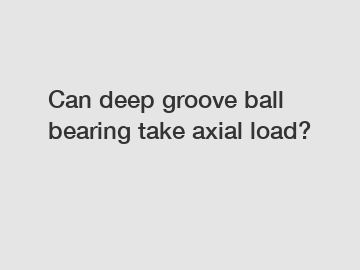Can deep groove ball bearing take axial load?
WZZG are exported all over the world and different industries with quality first. Our belief is to provide our customers with more and better high value-added products. Let's create a better future together.
Deep groove ball bearings are ubiquitous in most mechanical systems, as they efficiently support radial loads. While their role in accommodating radial forces is well-established, it can be a subject of confusion and uncertainty whether they can handle axial loads. In this article, we will delve into the inner workings of deep groove ball bearings and explore their capabilities when it comes to axial loads. So, let's embark on this enlightening journey to uncover the truth!
Understanding Deep Groove Ball Bearings:

Deep groove ball bearings are a type of rolling-element bearing, specifically designed to handle radial loads. They consist of an outer ring, an inner ring, a series of balls, and a cage that holds the balls in place. Their smooth and resilient design allows them to support rotational and radial forces while minimizing friction.
Role of Deep Groove Ball Bearings:
Deep groove ball bearings are primarily engineered to carry radial loads, including those resulting from linear and rotational movements. Their efficient design ensures smooth operation and reduced energy consumption, making them ideal for various applications in industries like automotive, machinery, and aerospace.
The Axial Load Conundrum:
The debate surrounding whether deep groove ball bearings can handle axial loads arises due to their primary purpose of supporting radial forces. Unlike thrust bearings, which are explicitly designed to accommodate axial loads, deep groove ball bearings often raise doubts due to their apparent limitations.
Axial Load Capacity:
Under normal operating conditions, deep groove ball bearings may tolerate a certain degree of axial load depending on their design, configuration, and other factors. However, it's crucial to note that excessive axial loads can lead to premature failure, reduced bearing lifespan, and compromised performance.
Factors Affecting Axial Load Capacity:
To determine the axial load capacity of a deep groove ball bearing accurately, several factors must be considered:
1. Ball Bearing Design: Deep groove ball bearings with specific design modifications, such as reinforced outer rings or increased radial clearance, may exhibit improved axial load handling capabilities.
2. Contact Angle: Deep groove ball bearings typically have a contact angle close to zero degrees, limiting their ability to sustain significant axial loads. In contrast, angular contact ball bearings have larger contact angles, making them better suited for predominantly axial load applications.
3. Bearing Preload: Proper preloading of a deep groove ball bearing can enhance its axial load capacity. This technique involves applying a controlled internal axial load to counteract any external axial forces, which ultimately helps distribute the load more evenly between the balls and races.
4. Load Direction and Magnitude: Axial loads exerted on deep groove ball bearings can be divided into pure thrust or combined radial-thrust loads. The magnitude and direction of the load significantly influence the bearing's ability to handle axial forces.
Conclusion:
Deep groove ball bearings are primarily designed to support radial loads and are not meant to bear significant axial loads. However, certain designs and modifications can improve their axial load capacity to a certain extent. It is crucial to evaluate the magnitude and direction of the load and choose the appropriate bearing type for optimal performance and longevity.
As with any mechanical system, consulting with bearing manufacturers, experts, and engineers is essential to determine the best-suited bearing type based on the specific application requirements. By considering all these factors, we can ensure efficient functioning, prolonged bearing life, and avoid premature failures.
So, while deep groove ball bearings might have their limitations when it comes to axial loads, they continue to play a pivotal role in countless radial load applications, reliably powering various industries worldwide.
If you want to learn more, please visit our website Radial cylindrical roller bearings features.



